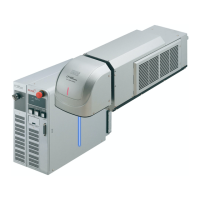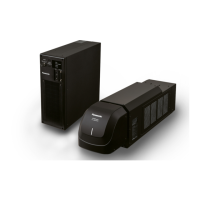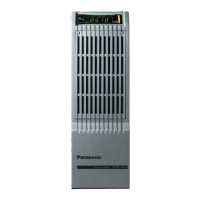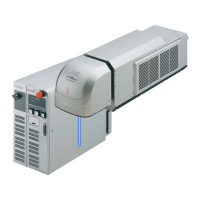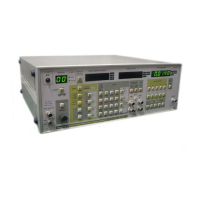Do you have a question about the Panasonic LP-V10U and is the answer not in the manual?
Critical safety precautions for avoiding serious injury or death.
Safety precautions to prevent serious injury or death.
Describes how to operate the laser marker using its screen interface.
Explains controlling the marker remotely via I/O or communication.
Visual guide for performing test marking and run mode operations.
Step-by-step guides for test marking and run mode operations.
Controlling the marker via I/O or serial communication in remote mode.
Illustrates an operation procedure when controlling the marker via external devices like PLC.
Outlines the sequence of settings required before initiating external control.
Details the function of DIP switch No. 2 for selecting control methods.
Explains the function of DIP switch No. 5 for setting remote mode.
Details the function of DIP switch No. 6 for selecting remote mode state at power-on.
How to configure output conditions for I/O signals.
How to select operations for I/O connector signals.
Setting communication parameters for Ethernet or RS-232C.
How to shift to remote mode using the controller's front switch.
How to shift to remote mode using the REMOTE IN I/O terminal signal.
Describes the I/O terminal block and connector for interface specifications.
Specifications for NPN and PNP type I/O terminal blocks.
Details the signals and their functions for the I/O terminal block.
Details of input signals A1 (+12V OUT), A2 (IN COM.), A3 (REMOTE IN), A4 (TRIG. IN).
Details for encoder, laser control, stop, alarm, and unused signals.
Details for output signals B1 (0V OUT), B2 (OUT COM.), B3 (REMOTE OUT).
Details for output signals indicating ready status, marking, warnings, and alarms.
Details for emergency stop output common and input signals.
Lists and details all signals available on the I/O connector.
Details for common terminals and the SET IN signal.
Details for D0-D15 input signals for various functions.
How to input file numbers and counter values for correction.
How to input counter reset numbers and rank/offset data.
Details for SELECT, TIME HOLD, and RESERVE input signals.
Details on RESERVE terminals and counter end output signals.
Describes the SET OK output signal indicating successful setting completion.
Details for the OUT COM./IN COM. terminal.
Electrical ratings and circuit diagrams for input signals.
Electrical ratings and circuit diagrams for output signals.
Example wiring for NPN models for independent operation.
Example wiring for PNP models for independent operation.
Lists commands for controlling operations like pumping, shutter, and status requests.
Detailed description of the ECR command for reading error codes.
Lists common start-up problems and their solutions.
Lists common issues related to laser pumping and their resolutions.
Lists issues related to the display and control panel, and their causes/measures.
Lists common problems encountered during the marking process and their solutions.
Lists issues affecting marking quality and provides remedies.
Lists causes and measures for character disorder or unreadable markings.
Lists problems related to marking moving objects and their solutions.
Lists issues with external control signals and serial communication.
Details failures in serial communication control and their causes.
Explains why commands might not be accepted by the marker (NAK response).
Describes alarm errors and procedures for releasing them.
Details various laser, system, and connection errors and their solutions.
Details errors related to unit combination, memory, lasing, and general system errors.
Describes warning errors and procedures for releasing them.
Errors related to marking area, characters, memory, and flying object operations.
Errors related to function usage, file conversion, measurement, and code creation.
Errors related to 2D code patterns, barcode creation, and dimensions.
Critical safety precautions for avoiding serious injury or death.
Safety precautions to prevent serious injury or death.
Describes how to operate the laser marker using its screen interface.
Explains controlling the marker remotely via I/O or communication.
Visual guide for performing test marking and run mode operations.
Step-by-step guides for test marking and run mode operations.
Controlling the marker via I/O or serial communication in remote mode.
Illustrates an operation procedure when controlling the marker via external devices like PLC.
Outlines the sequence of settings required before initiating external control.
Details the function of DIP switch No. 2 for selecting control methods.
Explains the function of DIP switch No. 5 for setting remote mode.
Details the function of DIP switch No. 6 for selecting remote mode state at power-on.
How to configure output conditions for I/O signals.
How to select operations for I/O connector signals.
Setting communication parameters for Ethernet or RS-232C.
How to shift to remote mode using the controller's front switch.
How to shift to remote mode using the REMOTE IN I/O terminal signal.
Describes the I/O terminal block and connector for interface specifications.
Specifications for NPN and PNP type I/O terminal blocks.
Details the signals and their functions for the I/O terminal block.
Details of input signals A1 (+12V OUT), A2 (IN COM.), A3 (REMOTE IN), A4 (TRIG. IN).
Details for encoder, laser control, stop, alarm, and unused signals.
Details for output signals B1 (0V OUT), B2 (OUT COM.), B3 (REMOTE OUT).
Details for output signals indicating ready status, marking, warnings, and alarms.
Details for emergency stop output common and input signals.
Lists and details all signals available on the I/O connector.
Details for common terminals and the SET IN signal.
Details for D0-D15 input signals for various functions.
How to input file numbers and counter values for correction.
How to input counter reset numbers and rank/offset data.
Details for SELECT, TIME HOLD, and RESERVE input signals.
Details on RESERVE terminals and counter end output signals.
Describes the SET OK output signal indicating successful setting completion.
Details for the OUT COM./IN COM. terminal.
Electrical ratings and circuit diagrams for input signals.
Electrical ratings and circuit diagrams for output signals.
Example wiring for NPN models for independent operation.
Example wiring for PNP models for independent operation.
Lists commands for controlling operations like pumping, shutter, and status requests.
Detailed description of the ECR command for reading error codes.
Lists common start-up problems and their solutions.
Lists common issues related to laser pumping and their resolutions.
Lists issues related to the display and control panel, and their causes/measures.
Lists common problems encountered during the marking process and their solutions.
Lists issues affecting marking quality and provides remedies.
Lists causes and measures for character disorder or unreadable markings.
Lists problems related to marking moving objects and their solutions.
Lists issues with external control signals and serial communication.
Details failures in serial communication control and their causes.
Explains why commands might not be accepted by the marker (NAK response).
Describes alarm errors and procedures for releasing them.
Details various laser, system, and connection errors and their solutions.
Details errors related to unit combination, memory, lasing, and general system errors.
Describes warning errors and procedures for releasing them.
Errors related to marking area, characters, memory, and flying object operations.
Errors related to function usage, file conversion, measurement, and code creation.
Errors related to 2D code patterns, barcode creation, and dimensions.
| Brand | Panasonic |
|---|---|
| Model | LP-V10U |
| Category | Measuring Instruments |
| Language | English |



